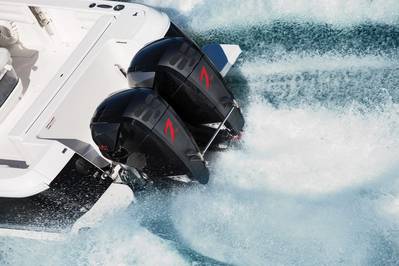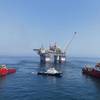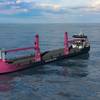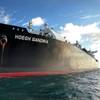Innovative Propulsion Systems for Fast Craft
Performance, Speed, Fuel Economy & Environmental compliance all come together to form the ultimate balancing act for engine OEM’s and their customers alike.
The ‘need for speed’ has been at the heart of professional fast craft operations since powerboats first overtook their bow wave and went on the plane. However, it is a hard fact of life for many professional organizations that fuel budgets are being cut. Engine manufacturers now recognize that high performance must be balanced with fuel economy and environmental compliance.
When fuel costs were less of an issue the marine industry solution to engine power for fast craft was often the same as the Detroit motor industry – install maximum horsepower, and then use the engines at lower revs until you need to go fast. The modern engine is designed to be used at continuous higher revs so downsizing engine size is now a viable consideration for reducing fuel bills and increasing range at sea.
Changing Scenarios
Traditional ‘boats’ in the last millennium were usually considered by definition to be carried on board a ship, then launched and recovered as required. Typical examples of boats around 25 feet, carried in davits onboard ships, include the US Navy 7 meter RHIB and the UK Royal Navy Pacific 24 RHIB. Propulsion requirements for these boats are simple; start on demand, get the boat on the plane – then do it again tomorrow! One engine usually meets these requirements.
Modern ‘ships’ include the smaller Offshore Patrol Vessels in the 25 meter (82 feet) to 50 meter (165 feet) range. These vessels operate in green or blue water and may be required to support lengthy coast guard and border actions, international peace keeping or disaster relief. Engine and propulsion requirements for these ‘ships’ are nothing like the requirements for ‘boats.’ OPV power specifications reflect self sufficiency, including continuous main engine running, with separate generator sets that support on board systems.
Part of the ‘changing world’ scenario for professional maritime organizations is the next generation of craft in the sub IMO sector (below 80 feet / 24 meter). Major innovations in both engines and propulsion technology are taking place in this dynamic sector between ‘boats’ and ‘ships’. In the shadow of global recession it is clear that industry has realized that innovations must be linked to genuine end-user requirements at procurement stage and reduced operating budgets. The major growth in fast craft development has been under 50 feet (15 meters). Established and new players are delivering propulsion technology solutions that range from slight percentage gains to game changers.
Inboards Adjust
In the diesel inboard sector various manufacturers; including Volvo Penta, Mercury, Yanmar and Cummins have recognized the growing professional sector demand for high performance diesel engines. Fast boat operators need to constantly adjust ‘power on / power off’, for example when running into a head sea or during boarding operations. The engineering challenge has been to combine the robust characteristics of diesel engines with reduced turbo lag and improved throttle response. Since the 1990s, the automotive sector, particularly in Europe, has driven the development of high performance diesel engines. Lighter weight blocks and components, combined with electronic fuel management systems and fly by wire controls are enabling the next generation of inboard diesels to close the ‘responsiveness’ gap with gasoline (petrol) outboards.
Many inboard engine manufacturers offer their own outdrive ‘legs’ that combine gears, steering and propellers. These stern drive units are designed to be installed with the OEMs own high performance diesel engines. Other manufacturers focus on specialist stern drive units that can be coupled with various engines. Konrad stern drives are designed for heavy duty applications where strength, reliability and long service life are required. Julie Heifner, Sales and Marketing Director of Konrad told MarineNews, “The main design requirement is for the stern drive unit to take the torque and the impulse load that comes from a diesel engine. When a high performance craft is running hard in waves, the loading effect of leaving and re-entering the water can be extreme.”
Konrad drives are compatible with most high performance diesel engines. The company has just announced the launch of their new 600B Series drive for commercial and military operations. Heifner adds, “The new system offers a thicker, wider, stronger transom unit - designed to spread the load across a larger area, making the entire unit extremely durable. Steering is integrated within the 600B Series unit. Two dual prop models are available, one which excels in performance, the other in high load carrying applications.”
Outboards: Emissions & Economy
In the high performance outboard sector various manufacturers, including Mercury, Honda, Yamaha and Suzuki have invested significant R&D budgets to comply with strict emission regulations, and the end-users need for improved fuel economy. Since the late 1990s, the transition has mainly resulted in the move from 2 stroke to 4 stroke engines, linked to electronic fuel management systems. A notable exception is Evinrude that have stayed with 2 stroke engines and developed their low emission technology E-TEC outboard range. OEM development programs have all recognized the demand for increased size of power units, with the largest gasoline outboards now delivering over 300 hp. Homeland security, coast guard, customs and border patrol craft in the 25 to 50 feet range have become demanding 24/7 work environments for these twin, triple and quad engine set ups.
At the 2011 Miami Boat Show, when the largest current outboard engine was 350hp, the launch by Seven Marine of a 557hp outboard was a significant event. Company President Rick Davis said, “The muscle for the 557 is provided by a fuel-injected marinized 6.2 litre supercharged small-block V8, managed by the General Motors MEFI 6 engine controller. Our first objective was a two engine, 1100 hp, setup that delivers the same horsepower as a four engine setup. We are now working with high performance boat builders developing three and four engine installations that take the combined outboard horsepower to over 2200 hp. With major weight savings and less appendages dragging in the water this development has caught the attention of naval architects and fast craft designers.”
Over the past two decades navy and air forces around the world have made the decision not to carry gasoline. From this decision high power diesel outboards have become a priority objective for both end-users and engine manufacturers. But there have been significant engineering challenges to overcome, particularly the size of unit and overall weight.
In the interim, multi-fuel engines have filled the needs of a specific group of operators. Jeff Wasil, Engineering Manager, at Evinrude said, “Fifteen years ago, Evinrude started to develop a Multi Fuel Engine (MFE) with, water jet propulsion, for the US Marine Corps and the SEAL teams. These units needed multi-fuel engines to power their fleets of Zodiac F470 Combat Rubber Raiding Craft, operating from ships and aircraft in harsh environments. The Evinrude MFE engines can be submerged and are designed to run on kerosene, aviation fuels and standard gasoline. Fuel selection can be changed with the simple flip of a switch. The 55 hp MFE attaches a large impeller pump jet unit to the gearcase for vectored thrust. There is also a propeller version of the 55 hp and a 30 hp model.”
Water Jets
Riverine and shallow water estuary operations also require specialist propulsion solutions for larger craft. Waterjets are the most common choice as it can withstand impacts with the river bottom without risking damage to a propeller. In addition, floating debris presents a significant concern, whether organic or inorganic. Joe Silkowski, Chief Operating Officer of specialist boat builder ReconCraft said, “Vegetation and debris are the nemesis of water jets. Anything that mitigates the risk of a disabling casualty caused by a fouled impeller or jet intake is worth considering. Marine reversing gears are a common addition to the power train to deal with fouled intakes and there is also new technology that helps to prevent the intake from getting fouled in the first place. Being able to rapidly clear debris from the water-jet offers a tremendous tactical advantage to the operator. In riverine settings, the order of importance is usually maneuverability, draft then speed. “
Old Demands Spur New Developments
Specialist UK small craft manufacturer, C-Fury, are developing a lightweight high thrust diesel inboard propulsion system, that will be optimised for craft under 20 feet (6 metre). The system combines the latest direct injection, two rotor turbo diesel Wankel engine, with contra rotating ducted propeller from a key technology specialist. C-Fury MD Simon Mcloughlin said, “Many potential customers for our craft operate from a mother ship. They want to use common fuel from the ship’s main tanks as it is safer and simpler for logistics. Our aim is to enable a fully loaded craft to have controlled acceleration from displacement through to a cruise speed of 25 knots. To safely achieve this in a small craft we need a system that delivers high bollard pull, significantly higher than current technologies. Our system has a very high mass flow.” The first prototype craft will be running in early 2015 for evaluation.
Until only recently, electric outboard motors had only made inroads into the lower horsepower ranges, mainly under 10 hp for small fishing boats, tenders and kayaks. The main obstacles to overcome before scaling up had been battery technology and the initial cost of procurement. Providing viable electric power for the automotive industry is a high value problem which has given battery manufacturers the opportunity to consider the differences with marine applications, including shock and vibration when a boat is underway plus the challenges of venting gasses from bilges and enclosed spaces. Developed by the German company Torqeedo, Deep Blue is an electric outboard system powered by batteries adapted specifically for the marine environment. Co-founder and CEO of Torqeedo, Dr. Christoph Ballin explains, “Deep Blue is a powerful electric drive that has been industrially developed and manufactured by Torqeedo, using only high-tech components. Deep Blue is environmentally friendly and the battery comes with a nine year capacity warranty. The drive system is available as inboard and outboard version with 40 hp and 80 hp. Twin systems can deliver up to 160 hp.” Zodiac MILPRO is currently using the Deep Blue 80 hp electric outboard system with its 20 feet (6 metre) SRM600 professional RIB.
Although industry has been working on potential innovations in various types of engine and propulsion technology for many years there has been one constant question around the RHIB and high speed craft sector: When will someone bring out a high performance diesel outboard? Marine Diesel of Sweden has talked openly about their diesel outboard development project for many years. The development has been taken over by the company Cimco Marinediesel, partially owned by Marinediesel in Sweden. Pre-launch information for a 200 hp diesel outboard named the OXE was recently released at HSBO in Sweden and MACC in the US.
The turbocharged diesel engine is a proven design that has been marinized in cooperation with the GM Group. Innovative features include a high torque belt-transmission, plus compact design of the lower housing which reduces drag and improves high speed capability. The engine runs on EN590, ASTM D 975, NATO F76, F75, F54, marine distillates DMX, DMA, (JP-5, JP-8, Jet A) fuel which gives high flexibility for operators. Christer Flodman, Technical Manager of Marine Diesel and the project manager for the OXE project said, “We started this project with a mission to design the first generation of high output diesel outboards. Our key words were durability, endurance and performance. The patented technology has enabled us to design a robust drive unit that will effectively transfer high torque diesel power. Serial pre-production of the OXE diesel outboard engine is planned to commence in mid 2015.”
Engines and propulsion systems that are designed and built for professional or commercial operations need to run hard, often for long hours in adverse sea conditions. Users must be able to rely on these products at all times. In certain situations, failure is not an option – the engineering must not break. Professional boat operators around the world have learned that power and performance are relevant, but reliability and durability, linked to a strong international service, spares and support network are important factors for all types of propulsion solutions.
(As published in the July 2014 edition of Marine News - http://magazines.marinelink.com/Magazines/MaritimeNews)










